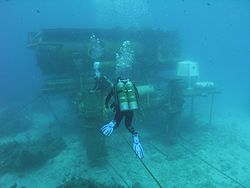- Aquarius (laboratory)
-
NOAA Aquarius Reef Base 
Aquarius on Conch Reef, off the Florida Keys
Established 1986 Research Type Underwater Research NOAA Location Florida Keys, Florida Operating Agency University of North Carolina–Wilmington Website Aquarius Reef Base
The NOAA Aquarius Reef Base is an underwater habitat located in the Florida Keys National Marine Sanctuary, adjacent to Conch Reef. It is one of the few underwater research facilities in the world dedicated to science. Aquarius is owned by the National Oceanic and Atmospheric Administration (NOAA) and operated by the University of North Carolina–Wilmington.[1]Contents
Purpose
Aquarius was built in Victoria, Texas, in 1986. Underwater operations first began in the U.S. Virgin Islands. Following Hurricane Hugo in 1989 Aquarius was taken to NURC for repairs and refurbishment and was redeployed in the Florida Keys in 1992. Aquarius is located under 20 m (62 ft) of water at the base of a coral reef within the Florida Keys National Marine Sanctuary, an ideal site for studying the health of sensitive coral reefs.
The laboratory is most often used by marine biologists, for whom Aquarius acts as home base as they study the coral reef, the fish and aquatic plants that live nearby and composition of the surrounding seawater. Aquarius houses sophisticated lab equipment and computers, enabling scientists to perform research and process samples without leaving their underwater facilities.
The habitat accommodates four scientists and two technicians for missions averaging ten days. Scientists on the Aquarius are often called "aquanauts". Dives from Aquarius can last for up to nine hours at a time, by comparison surface dives usually last between one to two hours. Long dive times allow for observation that would not otherwise be possible.
Habitat Structure
Aquarius consists of three compartments. Access to the water is made via the 'wet porch', a chamber equipped with a moon pool, which keeps the air pressure inside the wet porch the same as the water pressure at that depth ('ambient pressure'), about 2.6 atmospheres, through hydrostatic equilibrium. The main compartment is strong enough, like a submarine, to maintain normal atmospheric pressure, and can also be pressurized to ambient pressure, and is usually held at a pressure in between. The smallest compartment, the Entry Lock, is between the other two and functions as an airlock in which personnel wait while pressure is adjusted to match either the wet porch or the main compartment.
This design enables personnel to return to the surface without the need for a decompression chamber when they get there. Personnel stay inside the main compartment for 17 hours before ascending as the pressure is slowly reduced, so that they do not suffer decompression sickness after the ascent.[2]
Underwater missions and research
Several missions on the Aquarius have been cancelled due to hurricane activity.
Since 2001, NASA has used Aquarius for its NEEMO (NASA Extreme Environment Mission Operations) program, to study various aspects of human spaceflight in a similar environment. Like the environment of space, the undersea world is a hostile, alien place for humans to live. Aquarius provides a safe harbor for scientists to live and work for weeks at a time.
References
- ^ Shepard AN, Dinsmore DA, Miller SL, Cooper CB, and Wicklund RI (1996). "Aquarius undersea laboratory: The next generation". In: MA Lang, CC Baldwin (Eds.) The Diving for Science…1996, "Methods and Techniques of Underwater Research" Proceedings of the American Academy of Underwater Sciences (Sixteenth annual Scientific Diving Symposium). http://archive.rubicon-foundation.org/4703. Retrieved 2008-06-15.
- ^ Gregory Stone: "Deep Science". National Geographic Online Extra (Sept 2003). Retrieved 29 July 2007.
General references
- ENN. Age of Aquarius: Undersea lab immersed in coral reef research, 2000.
- NOAA. Hurricane Charlie cuts short Aquarius undersea mission, 2004
- Plain, C. From the Ocean Depths to Deep Space, 2004
- http://magma.nationalgeographic.com/ngm/0309/feature4/fulltext.html
External links
Categories:- National Oceanic and Atmospheric Administration
- Oceanography
- Underwater habitats
Wikimedia Foundation. 2010.

